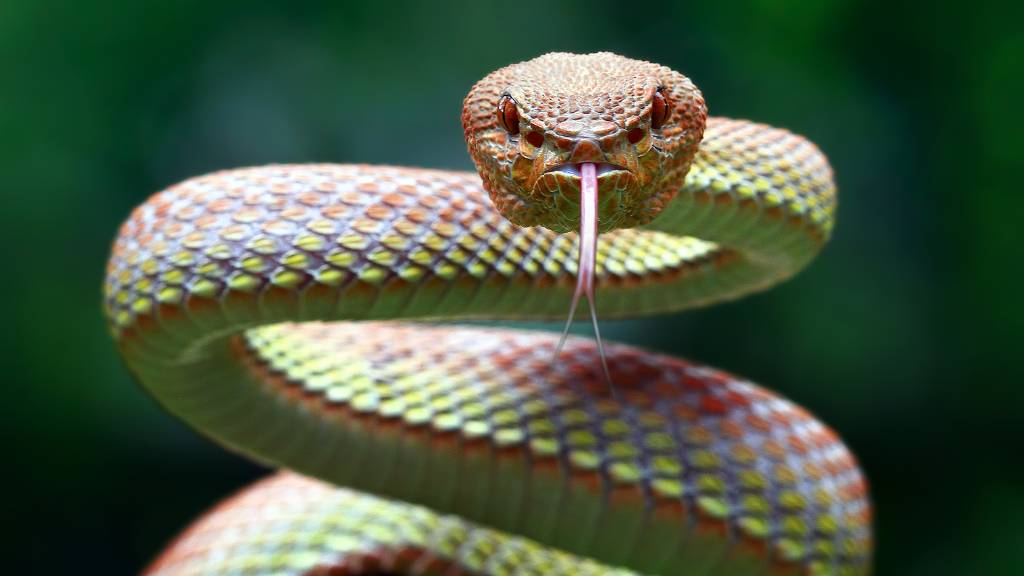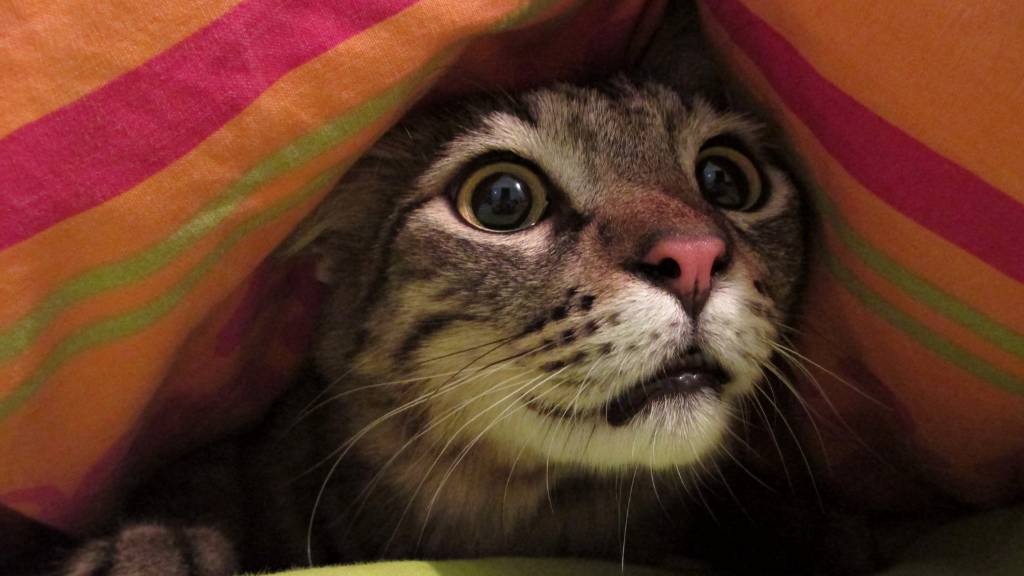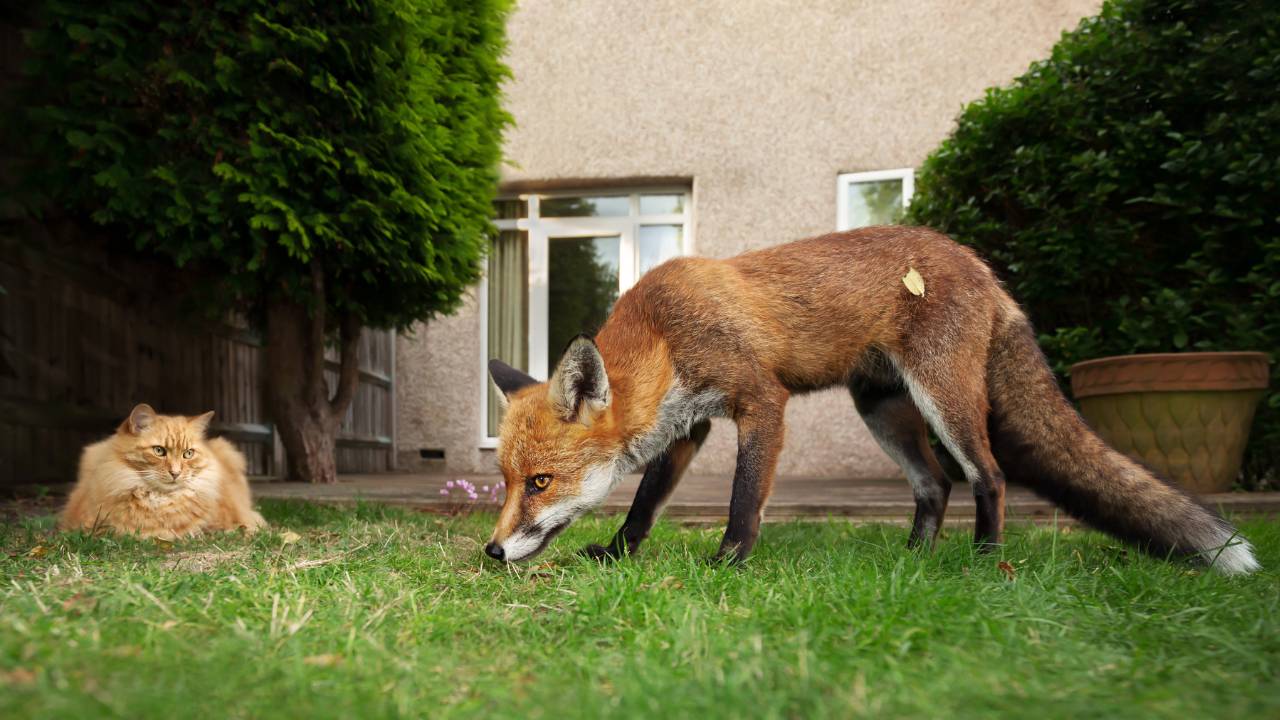Pet parents everywhere are Googling “do foxes eat cats?” after hearing one too many stories from the neighbor down the street.
Foxes are becoming more common in suburban backyards. But are they really hunting our feline friends, or is this a backyard myth gone wild?
Let’s break down what’s fluff, what’s fact, and how to keep your whiskered wanderer safe without ruining their nightlife.
Will a Fox Attack a Cat? Breaking Down Behavior 😨
Seeing a fox near your cat can be scary. Foxes are meat-eaters, but they usually go for small, easy meals like rodents or leftovers, and not full-grown cats. Most healthy adult cats are too big, fast, or confident to be worth the risk.
Still, a fox might attack if it feels threatened, is very hungry, or is protecting its young. Smaller cats or kittens may be at greater risk, especially at night.

In most cases, when a fox and a cat cross paths, nothing happens. Cats often hiss or puff up to scare off the fox. Foxes tend to back away rather than start a fight. These two animals usually keep their distance and avoid each other.
Do Foxes Hunt Cats or Scare Them Off? 😱
It’s easy to assume the worst when your cat disappears for an hour and a fox has been spotted nearby. But do foxes hunt cats with real intent, or is it all drama and no action?
In truth, foxes rarely stalk cats. Their usual prey includes rabbits, mice, and birds. These animals are quiet, defenseless, and easy to catch. Chasing a sharp-clawed, quick-footed cat takes more effort than most foxes are willing to risk.
Some cats are more susceptible to certain conditions than others. Kittens, older cats, or those with limited mobility may be more likely to attract attention.

While uncommon, there have been instances where foxes preyed on cats, particularly in areas where food is scarce or fox populations are abundant.
Most of the time, a confident cat is enough to make a fox back off. These animals are not looking for a fight. They prefer an easy target, and cats rarely qualify.
Do Foxes Kill Cats? How Rare Is It? 🫣
Most pet owners worry about this one. If you’ve spotted a fox nearby or heard strange noises at night, it’s natural to wonder: do foxes kill cats?
Fortunately, it’s very rare. One UK veterinary expert told the Royal Veterinary College that only about 5 out of 10,000 cats had any injuries from a fox. In comparison, over 500 had bites from other cats. Many vets have never even seen a fox-related injury. Some say the only known cases involved very old or deaf cats who couldn’t defend themselves.

Now, can a fox kill a cat? Yes, it’s possible, especially if the cat is a kitten, weak, or sick. But again, healthy adult cats are usually too fast and strong. Foxes prefer easy meals like rodents or food scraps. They don’t go looking for a fight with a confident cat.
Some pet owners report cats disappearing when foxes or other wild animals are nearby. You can read more about animals that attack cats in similar environments.
But in most of these cases, the fox didn’t hunt the cat. It might have found a cat that had already died and scavenged the body. This was the case in the “Croydon Cat Killer” story in London, which turned out to be a case of scavenging.
So yes, foxes attacking cats can happen, but it’s rare, and usually only in special situations.
What Puts Your Cat at Risk (and What Doesn’t) 😬
Not every cat is at equal risk. Some are easier targets, and it mostly comes down to their condition and where they roam.
Kittens, senior cats, and injured pets are more vulnerable. They may not be able to escape quickly or sense nearby threats. In these cases, a fox can kill a cat, especially if the fox is hungry or feels cornered.
Foxes tend to be most active during twilight hours—early morning, late evening, and overnight. If your cat explores during those times, especially near woods or quiet spaces, there’s a higher chance of a run-in. Urban foxes also wander through backyards, side streets, and even porches.

What is the safest approach? Keep your cat indoors when fox activity is likely. Nighttime is especially risky. If you’ve wondered if foxes are dangerous to cats, the answer depends more on your cat’s age, health, and habits than on the fox alone.
If you’re looking to adopt, choose from our verified list of kittens for sale and learn how to protect them from common outdoor risks.
Protecting Your Cat Without Paranoia 🛡️
Worried about foxes doesn’t mean you have to panic. With a few smart habits, you can keep cats safe from foxes without turning your home into a fortress.

Start with the basics:
- Keep your cat indoors at night. This one change lowers the risk more than anything else.
- Feed cats inside or remove bowls after outdoor meals. Leftover food attracts foxes.
- Use motion-activated lights or sprinklers around the yard to make foxes think twice.
If your cat enjoys time outside during the day, create a secure space. A “catio” or enclosed garden run lets them enjoy fresh air without wandering into trouble. Solid fencing that’s at least six feet high with no gaps near the ground can also help deter curious foxes.
You don’t need to patrol the yard. Just be aware of patterns. If you start seeing foxes frequently or notice bold behavior, that’s the time to contact your local wildlife expert or animal control.
These cat safety tips are simple ways to give your pet the freedom they love while giving you peace of mind.
More Likely Threats to Cats Than Foxes 😼🚨
Foxes get most of the attention, but several other animals pose a greater risk to cats—especially those who roam outdoors. Here’s what to watch for, how serious the danger is, and how to keep your cat safer.
1. Coyotes 🦨
Threat level: High

Coyotes are one of the biggest threats to outdoor cats, especially in suburban areas near woods or open land. They hunt silently, move quickly, and have no problem taking on a small pet. Unlike foxes, coyotes see cats as food and will go after them if given the chance.
Tip: Never let your cat roam at night, especially near wooded areas. Secure fencing with a “coyote roller” or angled top can prevent entry into yards.
2. Large Birds of Prey 🦅
Threat level: Moderate for kittens and small cats

Hawks, eagles, and owls have sharp talons and strong vision. While they usually hunt rodents, they’ve been known to grab kittens or small cats left alone in open spaces. These attacks are rare but dangerous.
Tip: Supervise small cats outdoors and avoid open, exposed areas. Add overhead protection like netting or shaded coverings to outdoor enclosures.
3. Dogs 🐕🦺
Threat level: Moderate to high (varies by location)

Loose or aggressive dogs can chase and injure cats in seconds. Even a friendly dog might see a cat as a toy, leading to accidental harm. Fenced yards don’t always stop a determined dog, so it’s smart to stay alert during walks or outdoor playtime.
Tip: Know your neighborhood. If loose dogs are a problem, avoid outdoor time without supervision. Secure your yard’s perimeter and don’t leave cats alone in front yards.
4. Raccoons 🦝
Threat level: Moderate

Raccoons may look harmless, but they can be territorial around food and will fight. If a cat surprises one near a garbage bin or pet bowl, the raccoon can lash out with its claws and teeth. These nighttime scuffles can end in serious injuries.
Tip: Don’t leave food or water bowls outside overnight. Lock trash bins tightly and avoid letting cats roam after dusk.
5. Snakes 🐍
Threat level: Moderate in certain regions

In certain regions, venomous snakes like rattlesnakes or copperheads can be a real danger to outdoor cats. Cats that explore rocky areas, tall grass, or woodpiles are most at risk. A single bite can be fatal if not treated right away.
Tip: Keep yards trimmed and free of brush, woodpiles, or tall grass. Avoid letting your cat roam near rocky or rural areas, especially during snake season.
6. Humans 🙎♂️
Threat level: High in urban or high-traffic areas

The most unpredictable threat is, unfortunately, people. Outdoor cats face risks from traffic, poisoned bait, or intentional harm. Even well-meaning strangers can unknowingly put a cat in danger.
Tip: Microchip your cat and use a secure collar with ID. Avoid letting cats roam freely in neighborhoods with traffic or reported pet safety concerns.
A Calm, Clear Approach to Cat Safety 🤝🐱
Seeing a fox nearby can trigger concern, but there’s no need to panic. Most foxes avoid cats and keep to themselves. The idea that they actively hunt cats is largely a myth.
Still, asking “Do foxes eat cats?” is reasonable. Knowing the facts helps you care for your pet with more confidence. Simple habits like supervising outdoor time, securing food sources, and watching for signs of wildlife make a real difference.
Pay attention to your cat’s routine. Trust your instincts. Stay informed about your surroundings. For trusted care guidance, visit our verified breeder directory and connect with experts who raise well-socialized, well-loved cats.






0 Comments